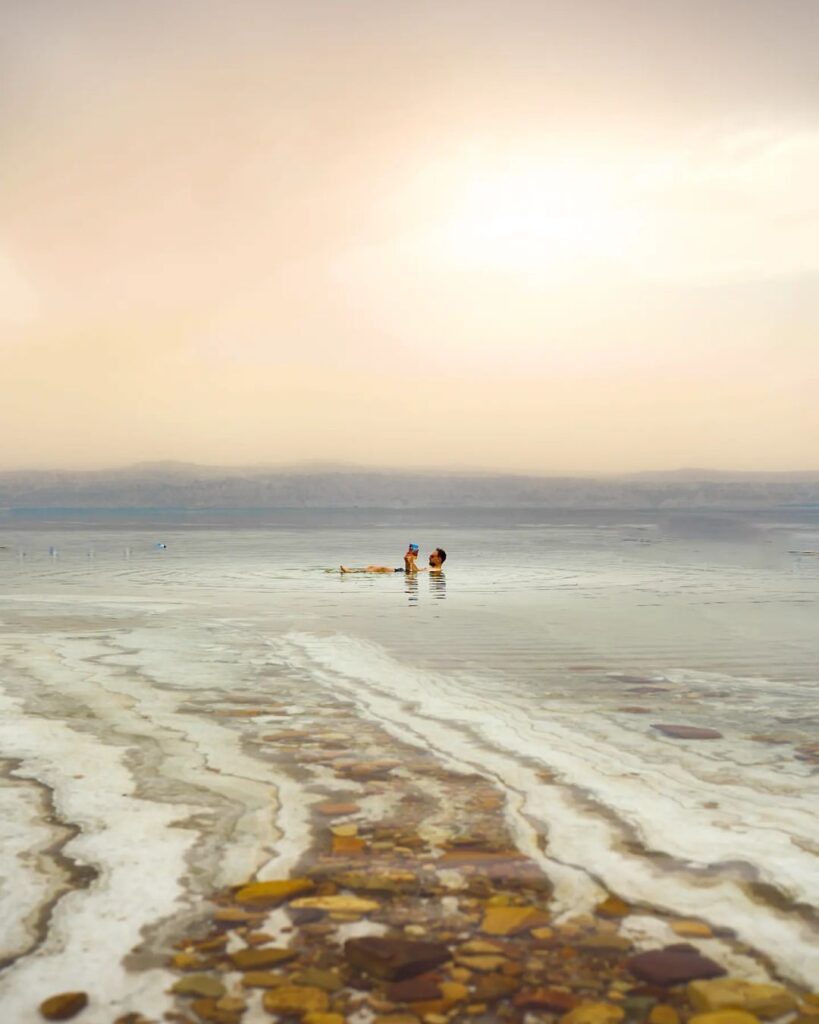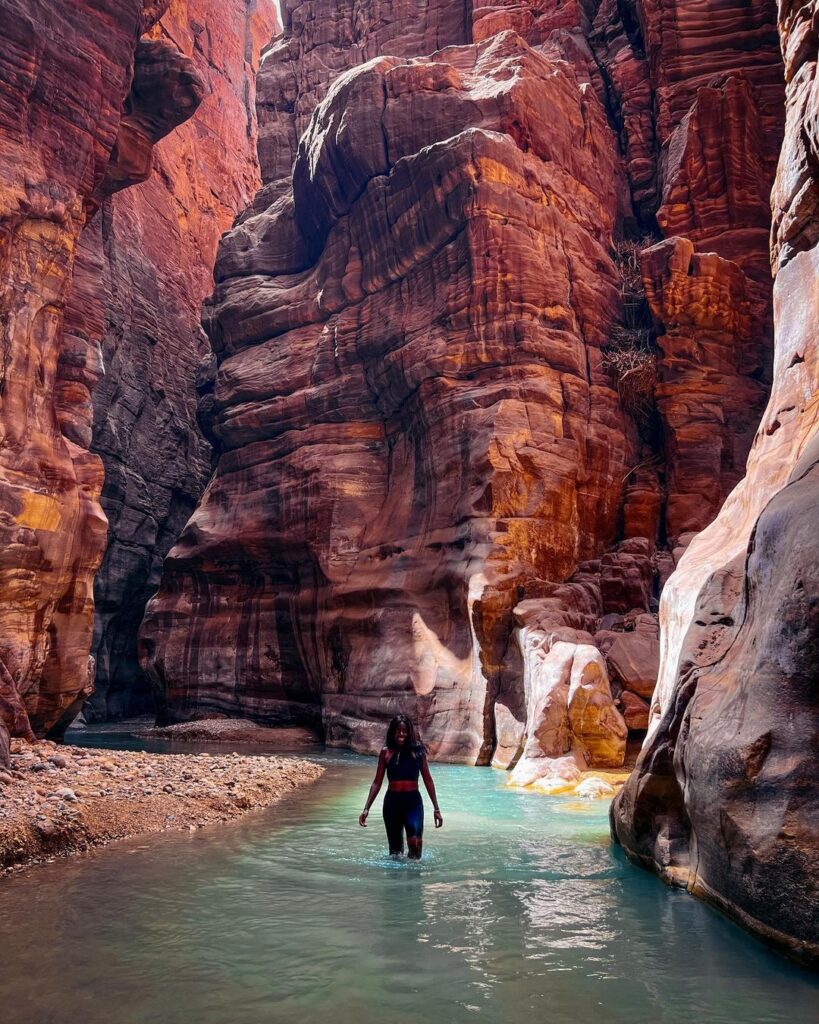During a trip to Jordan, exploring the Dead Sea is a must. But what to do after your swim? The northern shores of this vast salt lake, at the crossroads of ancient Moab and Canaan, offer stunning biblical sites and amazing natural views.
Surrounded by limestone mountains and patches of salt, the bright blue Dead Sea stands out against the barren land. Floating in its thick waters and covering yourself in its mineral-rich mud is fun and good for your skin. But after 20 minutes, the high salt starts to sting, so you’ll need a freshwater shower. Nearby, there are many amazing heritage and natural sites to explore. Here are essential things to do at the Dead Sea to make the most of your day, blending relaxation, sport, and culture, all within 30 minutes from the beach.
Table of Contents
Float on the Dead Sea

Who doesn’t want to float effortlessly in the salty waters or enjoy an adventure in the weightless salt bath of the Dead Sea? The saltiest sea in the world offers unique sensations. The dense waters create a buoyant force that makes the body float on the surface, with even the slightest movement causing imbalance. But be careful, between the intense sun and high salinity, it’s not safe to stay in too long. A freshwater shower is essential after swimming, and both public and hotel beaches are equipped with them.
The Dead Sea has many health benefits too. Breathing the air, rich in bromine and sulfur, calms the nervous system. Coating your body with its mineral-rich black mud soothes rheumatism and skin conditions like psoriasis, vitiligo, and eczema. Plus, it leaves your skin feeling as soft as a baby’s.
Where to Swim?
All hotels along the northern Dead Sea offer free direct access to the sea for their guests. The Amman Dead Sea Beach is a paid private beach (€35) with umbrellas, a swimming pool, and a restaurant. The public beach is free, with “showers” (pipes along the road) available for €1.
Gain height on Mount Nebo

It was on this mountain overlooking the Dead Sea that Moses died at the age of 120. His journey from Egypt ended at Mount Nebo, from where he could see the Promised Land, which God had forbidden him to enter. Standing at 817 meters, the mountain offers views of the Dead Sea, the Jericho oasis, the Jordan Valley, and on clear days, the buildings of Jerusalem peeking above the distant peaks. The road to the top winds along the rocky mountainside, where herds of goats graze on sparse brushwood.
The rolling hills stretch out in every direction, forming spectacular and mesmerizing panoramas. At the summit, a small Franciscan community welcomes pilgrims and tourists from all over the world. They come to walk where Moses walked, enjoy the stunning views, and admire the mosaics of an ancient Byzantine basilica. Discovered by chance, these mosaics are among the best-preserved in Jordan. Two large flowerbeds framing the nave feature rural motifs. One mosaic depicts an African man holding an ostrich on a leash, while another shows a person in Persian attire accompanied by a zebra and a camel.
Moses Memorial and Mount Nebo. Open from 8 a.m. to 6 p.m. from April to October and from 8 a.m. to 5 p.m. from November to March. Entrance: €4.20.
Immerse yourself in the Jordan River at the site of Christ’s baptism

Beyond geopolitical issues, Israel and Jordan have long debated the exact location where Jesus was baptized. Jordan appears to have the upper hand, supported by biblical references, historical accounts from pilgrims, and archaeological excavations. Several churches have been unearthed, the oldest dating back to the 4th century. Steps once led down to the river for baptisms. However, the river shifted west after numerous medieval earthquakes.
Today, the once-turbulent river is a muddy stream winding lazily through palms and gorse. Despite its modest appearance, it remains deeply symbolic. Pilgrims come alone or in groups to pray, sing, and be baptized. The site also features Elijah’s Hill, where the prophet is said to have ascended to heaven in a chariot of fire. Nearby, a cave converted into a chapel is believed to have housed Saint John the Baptist. In Bethany, the foundational stories of Christianity come to life, offering a profound spiritual experience that transcends religious boundaries.
Baptismal site of Jesus Christ . Open from 8 a.m. to 6 p.m. from April to October and from 8 a.m. to 4 p.m. from November to March. Entrance: €16.50. Guided tour required.
Experience adventure at Wadi Mujib

The mountains bordering the Dead Sea are etched with numerous furrows carved by flowing waters. Wadi Mujib is undoubtedly the most spectacular among them. It offers a perfect excursion to cool off at the lowest point on earth, which is also one of the hottest. A torrent from the vast eastern desert carved a deep channel through the high plateaus of the King’s Road, emptying into the Dead Sea. Access to the canyon is at the outlet, about twenty minutes south of the resorts. A footbridge leads to the riverbed, which you hike up against the current.
The high cliffs of ocher and pink sandstone rise dramatically, enclosing a lively river. The changing light, polished walls, and translucent water create a stunning palette of colors and textures. The journey is spiced up with moderate challenges: crossing natural swimming pools with the help of ropes or climbing stone dams using a series of stairs. After a kilometer, the canyon opens up to a high waterfall, with a cave hidden behind its curtain of water. The descent involves floating with the current in deeper sections, gazing up at the blue sky.
To explore Wadi Mujib, appropriate clothing is essential—wear non-slip shoes and shorts or Bermuda shorts. A waterproof bag, available for rent at the reception, is handy for carrying your camera.
Wadi Mujib. Open from 8 a.m. to 5 p.m. from April to October. The canyon may be closed due to weather conditions or if the water level is too high. Prohibited for under 18s. Entrance: €29.

![12 Best Train Journeys In The World [2025 Updated] 1 paul szewczyk 2MqWiLkp6b4 unsplash 1024x503 1](https://artandthensome.com/wp-content/uploads/2024/08/paul-szewczyk-2MqWiLkp6b4-unsplash-1024x503-1.webp)
![12 Best Middle East Honeymoon Destinations [2025 Updated] 2 Middle East Honeymoon Destinations](https://artandthensome.com/wp-content/uploads/2023/05/pexels-enrique-15183443-150x150.jpg)


